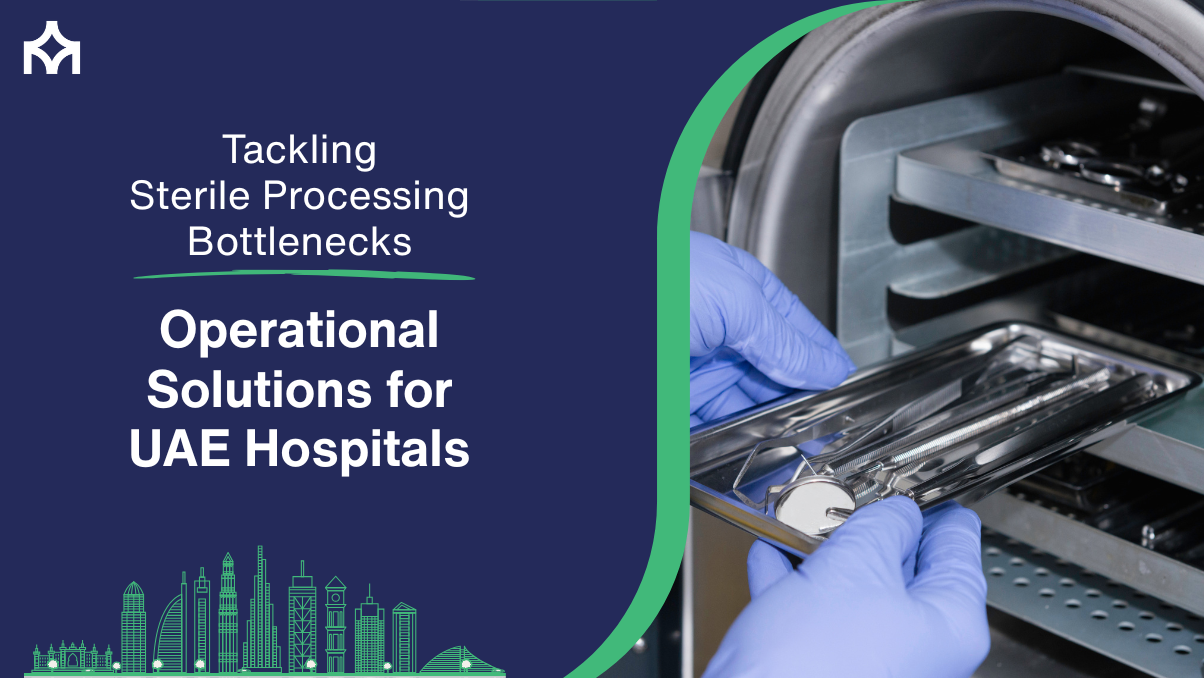Tackling Sterile Processing Bottlenecks: Operational Solutions for UAE Hospitals
Tackling Sterile Processing Bottlenecks: Operational Solutions for UAE Hospitals
Central Sterile Processing (CSP) is the unsung backbone of safe surgical care. In UAE hospitals where surgical volumes are growing, regulatory scrutiny is rising, and health systems are pursuing world-class outcomes CSP performance directly affects operating room (OR) throughput, patient safety, and financial efficiency. Yet many CSP units operate with outdated workflows, staffing shortages, and fragmented data systems, producing delays that cascade into cancelled cases, longer wait times and increased risk of adverse events.
This article outlines pragmatic, operational solutions UAE hospitals can implement now to reduce CSP bottlenecks and convert sterile processing into a reliable enabler of surgical excellence.
CSP failures have measurable clinical and economic consequences. Instrument reprocessing lapses are linked to a meaningful share of surgical site infections (SSIs) (American Journal of Infection Control, 2023), and OR downtime is costly, estimates range from $20–$80 per minute depending on the facility (AORN, 2024).
Meanwhile, workforce data indicate significant vacancy and turnover pressures in sterile processing departments (Healthcare Purchasing News, 2024). For UAE hospitals aiming to meet frameworks such as Jawda and international accreditation standards, addressing CSP is a strategic priority (DOH Abu Dhabi, 2025).
Practical and Smart High-Impact Solutions
-
Treat CSP as a clinical service, not a backroom function:
Leadership should reposition CSP within surgical services governance. That means giving CSP representation in perioperative committees, including sterile processing leads in surgical planning meetings, and measuring CSP KPIs (turnaround time, instrument availability, error rates) alongside OR performance metrics. -
Invest in workforce competency and retention:
Structured training, competency validation, and career pathways reduce errors and improve morale. Programs that support certification and continuing professional development have been shown to reduce reprocessing mistakes (IAHCSMM, 2023). In the UAE context, link training to licensure/recognition pathways and offer shift flexibility or incentive pay to retain skilled technicians. -
Digitize instrument tracking and communications:
Adopt RFID or barcode-based instrument tracking to replace manual logs. Real-time visibility of tray locations and sterilization status reduces lost instruments and prevents last-minute OR delays. Integrate CSP tracking with the hospital’s OR scheduling system so staff sees expected tray availability and turnover windows. -
Redesign workflows using Lean principles:
Apply Lean / Six Sigma to eliminate waste: standardize tray contents, optimize layout to reduce motion, batch sterilization intelligently, and create one-way flows for sterile and non-sterile items. Many hospitals have cut tray turnaround by up to 30% after reconfiguring physical layouts and standardizing processes (industry case studies). -
Strengthen cross-disciplinary coordination:
Regular huddles between surgeons, perioperative nurses, and CSP managers reduce miscommunication and align expectations especially for complex cases that require special instrument sets. Shared dashboards and simple escalation protocols prevent last-minute surprises. -
Leverage automation for repetitive tasks:
Automated washers, sterilizers with integrated data logging, and AI-driven scheduling can improve throughput and compliance. Automation reduces manual error and frees technicians to focus on quality control and problem-solving. -
Create surge-capable supply strategies:
For high-volume periods or specialty cases, develop contingency plans dedicated backup trays, rapid external reprocessing partnerships, or regional sterile hubs to prevent single-point failures from disrupting surgical schedules. -
Embed quality and compliance monitoring:
Implement routine audits, root-cause analysis for incidents, and continuous improvement cycles. Align CSP metrics with national quality frameworks (e.g., Jawda) and accreditations such as JCI to demonstrate compliance and drive improvements.
Measuring Success: KPIs That Matter
Track and report: tray turnaround time, instrument availability rate, reprocessing error rate, OR case delay minutes attributable to CSP, and staff competency pass rates. Transparency of these KPIs empowers leaders to prioritize investments and measure ROI.
Closing: CSP As A Strategic Lever
For UAE hospitals striving for excellence, CSP is not a peripheral cost center, it is a strategic lever for surgical safety, operational resilience, and patient trust. By investing in workforce development, digitization, workflow redesign, automation, and cross-department governance, hospitals can eliminate chronic delays and transform sterile processing into a driver of reliable perioperative care.
Modality Global Advisors helps health systems assess CSP performance, design operational fixes, and implement scalable solutions tailored to UAE regulatory and operational realities. To discuss a CSP diagnostic or operational improvement plan, contact our perioperative team.
Sources: American Journal of Infection Control (2023); Association of periOperative Registered Nurses (AORN) – OR efficiency estimates (2024); Healthcare Purchasing News – sterile processing workforce data (2024); International Association of Healthcare Central Service Materiel Management (IAHCSMM) – certification outcomes (2023); Department of Health – Abu Dhabi (Jawda Quality Framework references, 2025).






